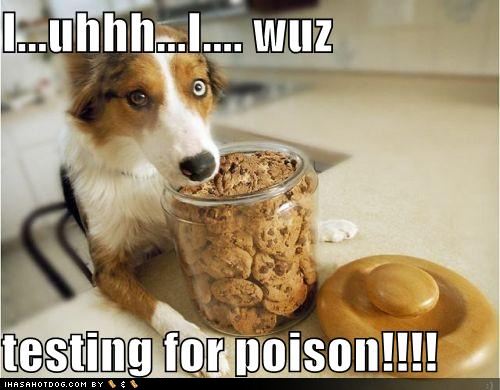Amy and me and baby Sorenne are headed to Boston, leaving Manhattan (Kansas) at 3 a.m. tomorrow. And whatever stresses come along, it’s good to remember the basics.
Amy and me, we like to write, and we make each other better. We also surround ourselves with others who want to do things better.
(1).jpg) Michael McCain (right, exactly as shown) may run a $5.5 billion a year company but Maple Leaf Foods has lousy writers. They’ve got the on-line thesaurus to find synonyms like stringent, thorough and rigorous, but the writers utterly fail to explain what this means.
Michael McCain (right, exactly as shown) may run a $5.5 billion a year company but Maple Leaf Foods has lousy writers. They’ve got the on-line thesaurus to find synonyms like stringent, thorough and rigorous, but the writers utterly fail to explain what this means.
Yesterday, Maple Leaf Foods Inc. reported a fourth quarter loss that narrowed on higher sales and helped by price increases, fluctuations in the Canadian dollar and contributions from acquisitions. Results, however, were impacted by the recall of meat products, contaminated with a strain of listeria bacteria, linked to the illness and death of several consumers.
Uh, 20 dead and at least 56 sick is not several consumers.
The same day, Maple Leaf announced that it is proceeding with a voluntary recall of approximately 1,100 cases of wieners produced at its plant in Hamilton, Ontario because the products were shipped in violation of the company’s rigorous food safety protocols. …
Under Maple Leaf’s stringent food safety protocols, the Company tests for listeria species, not Listeria monocytogenes. Six species of Listeria exist, but only one, Listeria monocytogenes, has any potential to impact human health. This is an extremely conservative approach as it treats any positive listeria test result with the highest level of corrective actions. Due to human error, a small quantity of wieners produced at the Hamilton plant that were quarantined under these routine enhanced procedures was inadvertently shipped to distribution centres and customers in Eastern Canada. All customers have been notified and product is immediately being removed from inventory or store shelves and returned to the Company.
Why is the Company capitalized? Will the Canadian economy shrivel if one questions the Company? And did Michael McCain call each customer?
"Unlike other situations, this event occurred as a direct result of human error and did not uphold our stringent industry leading protocols." said Michael McCain, President and CEO of Maple Leaf Foods. "Notwithstanding the exceptionally low risk this represents, Maple Leaf is committed to maintaining the most stringent standards and we intend to live by those standards so consumers can have absolute confidence in the integrity of our products. We are taking immediate action and will not condone anything other than strict adherence to our protocols."
That’s a lot of words to say we screwed up, again. But it gets better.
"As we have seen with the wide range of food products which have been recalled to date in 2009, as enhanced surveillance becomes more pervasive in the food industry, positive listeria findings and related recalls will occur more frequently. This should be regarded positively as it provides assurance that the industry and government are acting swiftly to protect public health", said Mr. McCain.
(2)(1).gif) Who is we? What are these food products that have been recalled in 2009? The ones that contain peanut paste shit? Or just listeria ones? Who’s enhanced surveillance? Sara Lee’s Bil Mar unit had a listeria outbreak linked to hot dogs that killed 20 in 1998. Why is Maple Leaf bragging about enhanced surveillance 10 years and another 20 deaths too late?
Who is we? What are these food products that have been recalled in 2009? The ones that contain peanut paste shit? Or just listeria ones? Who’s enhanced surveillance? Sara Lee’s Bil Mar unit had a listeria outbreak linked to hot dogs that killed 20 in 1998. Why is Maple Leaf bragging about enhanced surveillance 10 years and another 20 deaths too late?
Maple Leaf has implemented the most stringent food safety system in Canada.
Canada? Where they have visiting U.S. Presidents sign a guest book and worship their vengeful beaver gods with offerings of back bacon and doughnuts (go to 1:25 min in the video below).
As I said in the Toronto Star this morning,
"People, especially kids, eat … processed hot dog wieners all the time (without cooking them) or just give them a quick zap in the microwave."
Michael McCain, since you’re the face of Maple Leaf, do you let your kids eat processed wieners straight out of the refrigerator? Should there be warning labels on packages of hot dogs not to eat them without cooking to a sufficient internal temperature?
 This bizarre information came from a single document released on Oct. 17 by the consumer marketing arm of a company called Clear Labs, which had found traces of human DNA in 2 percent of the products sampled.
This bizarre information came from a single document released on Oct. 17 by the consumer marketing arm of a company called Clear Labs, which had found traces of human DNA in 2 percent of the products sampled.

 that the insect’s “head, eyes, and wings are visible. Insect is black in color, over 1-inch long.”
that the insect’s “head, eyes, and wings are visible. Insect is black in color, over 1-inch long.” his crop fields in an attempt to kill raccoons.
his crop fields in an attempt to kill raccoons. During my undergraduate days in Canada I tended to grab a bite after hitting the town. Though I rarely do it now (BK burgers just aren’t made with the same care at 3am), I do recall scarfing down hotdogs from street vendors during the wee hours of the morning.
During my undergraduate days in Canada I tended to grab a bite after hitting the town. Though I rarely do it now (BK burgers just aren’t made with the same care at 3am), I do recall scarfing down hotdogs from street vendors during the wee hours of the morning. Frank Sasso, health officer for Hoboken, where there are 33 food cart and food truck licenses, said,
Frank Sasso, health officer for Hoboken, where there are 33 food cart and food truck licenses, said, Carrie Pich of Windsor, Ontario
Carrie Pich of Windsor, Ontario.jpg) Both products are among those listed in the recall.
Both products are among those listed in the recall.(2).jpg) CEO Micheal McCain said
CEO Micheal McCain said.jpg) • Warning labels. Pregnant women and other at-risk populations should be informed of listeria risks, using a variety of messages and a variety of media. The
• Warning labels. Pregnant women and other at-risk populations should be informed of listeria risks, using a variety of messages and a variety of media. The  On July 7, 2009,
On July 7, 2009, 
(1).jpg) Michael McCain (right, exactly as shown) may run a $5.5 billion a year company but Maple Leaf Foods has lousy writers. They’ve got the on-line thesaurus to find synonyms like stringent, thorough and rigorous, but the writers utterly fail to explain what this means.
Michael McCain (right, exactly as shown) may run a $5.5 billion a year company but Maple Leaf Foods has lousy writers. They’ve got the on-line thesaurus to find synonyms like stringent, thorough and rigorous, but the writers utterly fail to explain what this means.(2)(1).gif) Who is we? What are these food products that have been recalled in 2009? The ones that contain peanut paste shit? Or just listeria ones? Who’s enhanced surveillance? Sara Lee’s Bil Mar unit had a listeria outbreak linked to hot dogs that killed 20 in 1998. Why is Maple Leaf bragging about enhanced surveillance 10 years and another 20 deaths too late?
Who is we? What are these food products that have been recalled in 2009? The ones that contain peanut paste shit? Or just listeria ones? Who’s enhanced surveillance? Sara Lee’s Bil Mar unit had a listeria outbreak linked to hot dogs that killed 20 in 1998. Why is Maple Leaf bragging about enhanced surveillance 10 years and another 20 deaths too late?